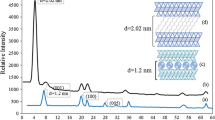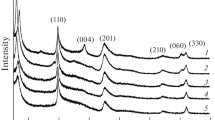Abstract
The adsorption of lead (II) ions on three Algerian montmorillonites (sodium, non-sodium, and acidic-activated) was studied. Transmission electron microscopy coupled with energy dispersive X-ray analysis, X-ray fluorescence and physical adsorption of gases were used to characterize the clays. This characterization has shown than the activation with acid increases the surface area as a consequence of the rupture of the laminar structure. The effect of the pH in the lead adsorption capacity was analyzed. The results show that adsorption is strongly depended on the pH. At low pH values, the mechanism that governs the adsorption behavior of clays is the competition of the metal ions with protons. Between pH 2 and 6, the main mechanism is an ion exchange process. The kinetics of the adsorption is tested with respect to pseudo-first-order and second-order models. The adsorption process, gives a better fit with the Langmuir isotherm, being the monolayer capacity ranging between 18.2 and 24.4 mg g−1. The adsorption of lead decreased in the order Acidic-M2 > M2 > M1. Thermodynamic parameters such as ΔH, ΔS, and ΔG were calculated. The adsorption process was found to be endothermic and spontaneous. The enthalpy change for Pb(II) by M1 adsorption has been estimated as 60 kJ mol−1, indicating that the adsorption of Pb(II) by all montmorillonites used corresponds to a physical reaction. The adsorption capacity of washed Acidic-M2 was very high compared to M2 and M1.






Similar content being viewed by others

References
Patterson JW. Industrial wastewater treatment technology. New York: Butterworth-Heinemann; 1985.
Adebowale KO, Unuabonah IE, Olu-Owolabi BI. The effect of some operating variables on the adsorption of lead and cadmium ions on kaolinite clay. J Hazard Mat. 2006;34:130–9.
Vogel C, Adam C, Unger M. Heavy metal removal from sewage sludge ash analyzed be thermogravimetry. J Therm Anal Calorim. 2011;103:243–8.
Adebowale KO, Unuabonah IE, Olu-Owolabi BI. Kinetic and thermodynamic aspects of the adsorption of Pb2+ and Cd2+ ions on tripolyphosphate-modified kaolinite clay. Chem Eng. J. 2008;136:99–107.
Arfaoui S, Frini-Srasra N, Srasra E. Application of clays to treatment of tannery sewages. Desalination. 2005;185:419–24.
Sakizci M, Alver BE, Yörükoğullari E. Termal and SO2 adsorption properties of some clays from Turkey. J Therm Anal Calorim. 2011;103:435–41.
Celis R, Hermosín MC, Cornejo J. Heavy metal adsorption by functionalized clays. Environ Sci Technol. 2000;34:4593–9.
Molina R, Vieiera-Coelho A, Poncelet G. Hydroxy-Al pillaring of concentrated clay suspensions. Clay Clay Miner. 1992;40:480–2.
Oubagaranadin JUK, Murthy ZVP. Adsorption of divalent lead on a montmorillonite-illite type of clay. Ind Eng Chem Res. 2009;48:10627–36.
Singh SP, Ma LQ, Hendry MJ. Characterization of aqueous lead removal by phosphatic clay: equilibrium and kinetic studies. J. Hazard Mater. 2006;136:654–62.
Mahbouba R, El Mouzdahir Y, Elmchaouri A, Carvalho A, Pinto M, Pires J. Characterization of a delaminated clay and pillared clays bynadsorption of probe molecules. Colloids Surf A. 2006;280:81–7.
Gok ASzcan, zcan A. Adsorption of lead(II) ions onto 8-hydroxy quinoline-immobilized bentonite. J. Hazard Mater. 2009;161:499–509.
Schoonheydt RA, Pinnavaia T, Lagaly G, Gangas N. Pillared clays and pillared layered solids. Pure Appl Chem. 1999;71:2367–71.
Stoch L, Bahranowski K, Budek L, Fijal J. Mineral Pol. 1977;8:31–7.
Srivastava SK, Tyagi R, Pant N, Pal N. Studies on the removal of some toxic metal ions, Part II. Removal of lead and cadmium by montmorillonite and kaolinite. Environ Technol Let. 1989;10:275–82.
Orumwense FFO. Removal of lead from water by adsorption on a kaolinitic clay. J Chem Technol Biotechnol. 1996;65:363–9.
Chantawong V, Harvey NW, Bashkin VN. Adsorption of lead nitrate on Thai kaolin and ballclay. Asian J Energy Environ. 2001;2:33–48.
Lapides I, Yari S. Thermo-X-ray-diffraction analysis of dimethylsulfoxide-kaolinite intercalation complexes. J Therm Anal Calorim. 2009;97:2–19.
Echeverría JC, Zarranz I, Estella J, Garrido JJ. Simultaneous effect of pH, temperature, ionic strength, and initial concentration on the retention of lead on illite. Appl Clay Sci. 2005;30:103–15.
Naseem R, Tahir SS. Removal of Pb(II) from aqueous/acidic solutions by using bentonite as an adsorbent. Water Res. 2001;35:3982–6.
Donat R, Akdogan A, Erdem E, Cetisli H. Thermodynamics of Pb2+ and Ni2+ adsorption onto natural bentonite from aqueous solutions. J Colloid Interface Sci. 2005;286:43–52.
Cicmanec P, Bulánek R, Frolich K. Thermodynamics of CO probe molecule adsorption on Cu–FER-zeolite comparison of TPD, FTIR, and microcalorimetry results. J Therm Anal Calorim. 2011;105:837–84.
Zamzow MJ, Eichbaum BR, Sandgren KR, Shanks DE. Removal of heavy metals and other cations from wastewater using zeolites. Sep Sci Technol. 1990;25:1555–69.
Ouki SK, Cheeseman C, Perry R. Effects of conditioning and treatment of chabazite and clinoptilolite prior to lead and cadmium removal. Environ Sci Technol. 1993;27:1108–16.
Brigatti MF, Lugli C, Poppi L. Kinetics of heavy-metal removal and recovery in sepiolite. Appl Clay Sci. 2000;16:45–57.
Bektas N, Agım BA, Kara S. Kinetic and equilibrium studies in removing lead ions from aqueous solutions by natural sepiolite. J Hazard Mat. 2004;112:115–22.
Juang RS, Lin SH, Tsao KH. Mechanism of sorption of phenols from aqueous solutions onto surfactant-modified montmorillonite. J Colloid Interface Sci. 2002;254:234–41.
Alberga L, Holm T, Tiravanti G, Petruzzelli D. Electrochemical determination of cadmium sorption on kaolinite. Environ Technol. 1994;15:245–54.
Tiller KG, Gerth J, Brümmer G. The sorption of Cd, Zn and Ni by soil clay fractions: procedures for partition of bound forms and their interpretation. Geoderma. 1984;34:1–16.
Stadler M, Schindler PW. The effect of dissolved ligands upon the sorption of Cu(II) by Ca-montmorillonite. Clays Clay Miner. 1993;41:680–92.
Belbachir M, Bensaoula A. US Patent 2001;No. 6, 274, 527 B1.
Lozano-Castelló D, Suárez-García F, Cazorla-Amorós D, Linares-Solano A. Porous texture of carbons. In: Beguin F, Frackowiak E, editors. Carbons for electrochemical energy storage and conversion systems. Florida: CRC Press; 2009. p. 115–62.
Cazorla-Amorós D, Alcañiz-Monge J, Linares-Solano A. Characterization of activated carbon fibers by CO2 adsorption. Langmuir. 1996;12:2820–4.
Cazorla-Amorós D, Alcañiz-Monge J, de la Casa-Lillo MA, Linares-Solano A. CO2 as an adsorptive to characterize carbon molecular sieves and activated carbons. Langmuir. 1998;14:4589–96.
Gu B, Schmitt J, Chen Z, Liang L, McCarthy JF. Adsorption and desorption of different organic matter fractions on iron oxide. Geochim Cosmochim Acta. 1995;59:219–29.
Kul AR, Koyunchu H. Heavy metal removal from municipal solid waste fly ash by chlorination and thermal treatment. J. Hazard Mater. 2010;179:332–9.
Ho YS, McKay G. Pseudo-second order model for sorption processes. Process Biochem. 1999;34:451–65.
Sing K, Everet D, Haul R, Moscou L, Pierotty R, Rouquerol J, Siemieniewska T. Reporting physisorption data for gas/solid systems with special reference to the determination of surface area and porosity. Pure Appl Chem. 1985;57:603–19.
Temuulin J, Jadambaa Ts, Burmaa G, Erdenechimeg Sh, Amarsanaa J, MacKenzie KJD. Characterisation of acid activated montmorillonite clay from Tuulant (Mongolia). Ceram Int. 2004;30:251–5.
Noyan H, Onal M, Sarikaya Y. The effect of sulphuric acid activation on the crystallinity, surface area, porosity, surface acidity, and bleaching power of a bentonite. Food Chem. 2007;105:156–63.
Huang FC, Lee FJ, Lee CK, Chao HP. Effects of cation exchange on the pore and surface structure and adsorption characteristics of montmorillonite. Colloid Surf A. 2004;239:41–7.
Treybal RE. Mass-transfer operation, 3rd ed. Tokyo: McGraw-Hill; 1981.
Elliot HA, Huang CP. Adsorption characteristics of some Cu(II) complexes on aluminosilicates. Water Res. 1981;15:849–55.
Unuabonah EI, Adebowale KO, Olu-Owolabi BI, Yang LZ, Kong LX. Adsorption of Pb(II) and Cd(II) from aqueous solutions onto sodium tetraborate-modified Kaolinite clay: equilibrium and thermodynamic studies. Hydrometallurgy. 2008;93:1–9.
Volesky B, Holan ZR. Biosorption of heavy metals. Biotechnol Prog. 1995;11:235–50.
Adebowale KO, Unuabonah IE, Olu-Owolabi BI. The effect of some operating variables on the adsorption of lead and cadmium ions on kaolinite clay. J Hazard Mater. 2006;134:130–9.
Jiang M, Jin X, Lu X, Chen Z. Adsorption of Pb(II), Cd(II), Ni(II) and Cu(II) onto natural kaolinite clay. Desalination. 2010;252:33–9.
Hefne JA, Mekhemer WK, Alandis NM, Aldayel OA, Alajyan T. Kinetic and thermodynamic study of the adsorption of Pb(II) from aqueous solution to the natural and treated bentonite. Int J Phys Sci. 2008;3:281–8.
Acknowledgements
This study has been financed by the AECID (projects AECID-PCI A/019533/08 and A/023858/09) and Ministerio de Ciencia e Innovación (project MAT2010-15273). The National Agency for the Development of University Research (CRSTRA), the Directorate General of Scientific Research and Technological Development (DGRSDT) of Algeria.
Author information
Authors and Affiliations
Corresponding author
Rights and permissions
About this article
Cite this article
Zehhaf, A., Benyoucef, A., Berenguer, R. et al. Lead ion adsorption from aqueous solutions in modified Algerian montmorillonites. J Therm Anal Calorim 110, 1069–1077 (2012). https://doi.org/10.1007/s10973-011-2021-8
Received:
Accepted:
Published:
Issue Date:
DOI: https://doi.org/10.1007/s10973-011-2021-8



